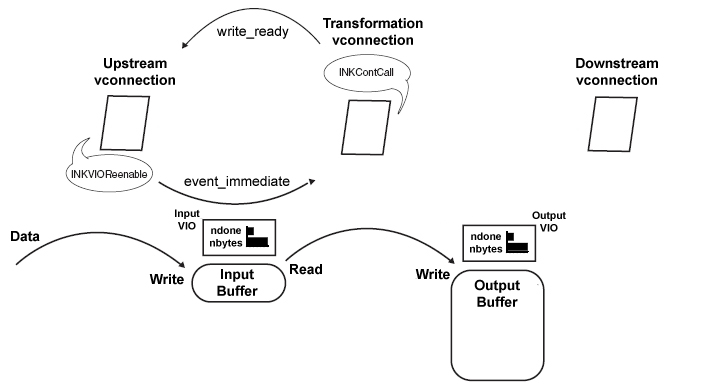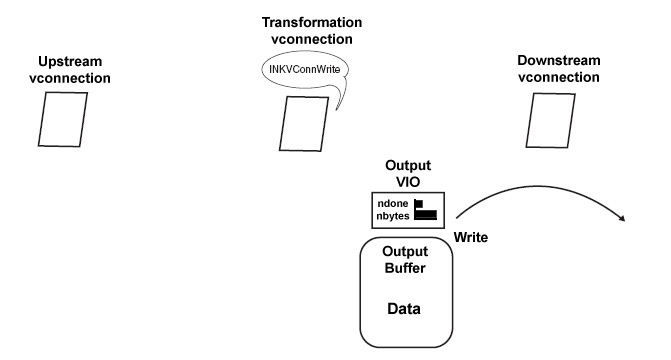Sample Buffered Null Transform Plugin¶
The buffered null transform, bnull_transform.cc, reads the response
content into a buffer and then writes the full buffer out to the client.
Many examples of transformations, such as compression, require you to
gather the full response content in order to perform the transformation.
The buffered null transform uses a state variable to keep track of when it is (a) reading data into the buffer and (b) writing the data from the buffer to the downstream vconnection.
The following is a step-by-step walk through the buffered null transform:
Gets a handle to HTTP transactions.
void TSPluginInit (int argc, const char *argv[]) { TSHttpHookAdd (TS_HTTP_READ_RESPONSE_HDR_HOOK, TSContCreate (transform_plugin, nullptr)); }
With this
TSPluginInitroutine, the plugin is called back every time Traffic Server reads a response header.Checks to see if the transaction response is transformable.
static int transform_plugin (TSCont contp, TSEvent event, void *edata) { TSHttpTxn txnp = (TSHttpTxn) edata; switch (event) { case TS_EVENT_HTTP_READ_RESPONSE_HDR: if (transformable (txnp)) { transform_add (txnp); }
The default behavior for transformations is to cache the transformed content (if desired, you also can tell Traffic Server to cache untransformed content). Therefore, only responses received directly from an origin server need to be transformed. Objects served from the cache are already transformed. To determine whether the response is from the origin server, the routine transformable checks the response header for the "200 OK" server response.
{ TSMBuffer bufp; TSMLoc hdr_loc; TSHttpStatus resp_status; TSHttpTxnServerRespGet (txnp, &bufp, &hdr_loc); if(TS_HTTP_STATUS_OK== (resp_status=TSHttpHdrStatusGet(bufp,hdr_loc))) { return 1; } else { return 0; } }
If the response is transformable, then the plugin creates a transformation vconnection that gets called back when the response data is ready to be transformed (as it is streaming from the origin server).
static void transform_add (TSHttpTxn txnp) { TSVConn connp; connp = TSTransformCreate (bnull_transform, txnp); TSHttpTxnHookAdd (txnp, TS_HTTP_RESPONSE_TRANSFORM_HOOK, connp); }
The previous code fragment shows that the handler function for the transformation vconnection is
bnull_transform.The
bnull_transformfunction has to handleERROR,WRITE_COMPLETE,WRITE_READY, andIMMEDIATEevents. If the transform is just beginning, the event received is probablyIMMEDIATE. Thebnull_transformfunction callshandle_transformto handleWRITE_READYandIMMEDIATE.The
handle_transformfunction examines the data parameter for the continuation passed to it (the continuation passed tohandle_transformis the transformation vconnection). The data structure keeps track of two states: copying the data into the buffer (STATE_BUFFER_DATA) and writing the contents of the buffer to the output vconnection (STATE_OUTPUT_DATA).Get a handle to the input VIO (see the
handle_bufferingfunction).input_vio = TSVConnWriteVIOGet (contp);This is so that the transformation can get information about the upstream vconnection's write operation to the input buffer.Copy data from the input buffer to the output buffer. See the
handle_bufferingfunction for the following code fragment:TSIOBufferCopy (data->output_buffer, TSVIOReaderGet (write_vio), towrite, 0);
Tell the input buffer that the transformation has read the data. See the
handle_bufferingfunction for the following code fragment:TSIOBufferReaderConsume (TSVIOReaderGet (write_vio), towrite);
Modify the input VIO to tell it how much data has been read (increase the value of
ndone). See thehandle_bufferingfunction for the following code fragment:TSVIONDoneSet (write_vio, TSVIONDoneGet (write_vio) + towrite); }
If there is more data left to read ( if ndone < nbytes), then the
handle_bufferingfunction wakes up the upstream vconnection by sending itWRITE_READY:if (TSVIONTodoGet (write_vio) > 0) { if (towrite > 0) { TSContCall (TSVIOContGet (write_vio), TS_EVENT_VCONN_WRITE_READY, write_vio); } } else {
The process of passing data through the transformation is illustrated in the following diagram. The transformation sends
WRITE_READYevents when it needs more data; when data is available, the upstream vconnection reenables the transformation with anIMMEDIATEevent.The following diagram illustrates the read from an input vconnection:
Reading Data Into the Buffer (the ``STATE_BUFFER_DATA`` State) {#ReadingDataIntoBuffer}

Reading Data Into the Buffer the STATE_BUFFER_DATA State¶
When the data is read into the output buffer, the
handle_bufferingfunction sets the state of the transformation's data structure toSTATE_OUTPUT_DATAand calls the upstream vconnection back with theWRITE_COMPLETEevent.data->state = STATE_OUTPUT_DATA; TSContCall (TSVIOContGet (write_vio), TS_EVENT_VCONN_WRITE_COMPLETE, write_vio);
The upstream vconnection will probably shut down the write operation when it receives the
WRITE_COMPLETEevent. The handler function of the transformation,bnull_transform, receives anIMMEDIATEevent and calls thehandle_transformfunction. This time, the state isSTATE_OUTPUT_DATA, sohandle_transformcallshandle_output.The
handle_outputfunction gets a handle to the output vconnection:output_conn = TSTransformOutputVConnGet (contp);The
handle_outputfunction writes the buffer to the output vconnection:data->output_vio = TSVConnWrite (output_conn, contp, data->output_reader, TSIOBufferReaderAvail (data->output_reader) );
The following diagram illustrates the write to the output vconnection:
Writing the Buffered Data to the Output Vconnection {#WritingBufferedtDataIntoVConnection}

Writing the Buffered Data to the Output Vconnection¶